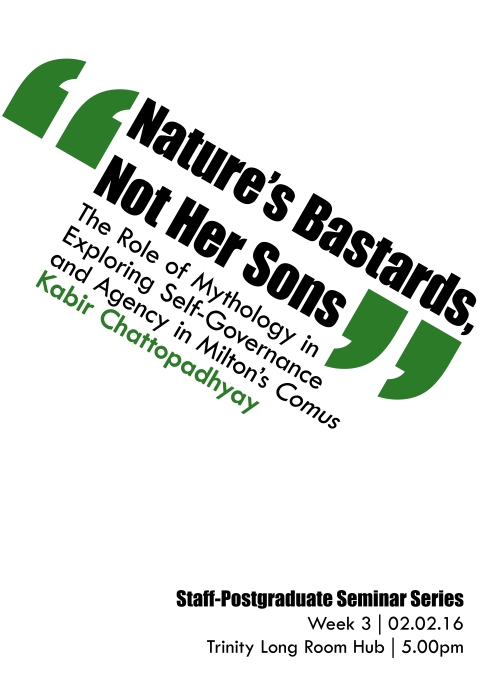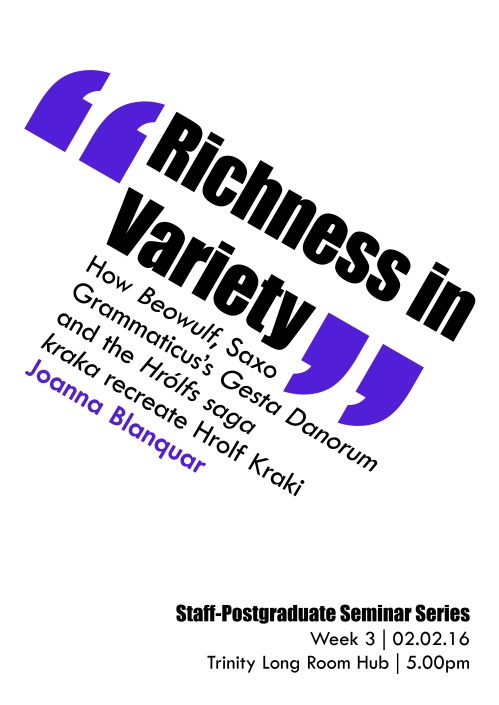Kabir Chattopadhyay
PhD Student, School of English

‘Nature’s Bastards, Not Her Sons’: The Role of Mythology in Exploring Self-Governance and Agency in Milton’s Comus
John Milton’s masque Comus was written and performed at Ludlow Castle, Shropshire, in 1634 to celebrate the appointment of John Egerton as the Lord President of Wales. The masque narrates the journey of three children (played by Egerton’s own children) through a dark forest, where they get separated only for the youngest girl to be tempted by the sorcerer Comus, who transforms his victims into bestial human-animal hybrids. In the end, the victimized child wins her freedom from enchantment by the virtue of her “Chastity and Temperance”, and some guidance from an Attendant Spirit and her siblings.
Exploring intertextual links and allusions between Milton’s masque and traditions of folklore and mythology can lead to a number of fascinating discoveries, mainly regarding Milton’s restructuring of the ideas of chastity and goodness in terms of self-governance and individual agency. I am concerned with the way the forest is set up as an independent, alternative space, cut-off from society and human habitat, and the way this opens up the opportunity to explore the dynamics of power that operate within the conflict between temptation and resistance. As an alternate space, the forest gives autonomy not only to Comus, unheralded lord of the realm, but also to the girl child; in the absence of familiar authority in the unfamiliar ‘other’ place, she must exercise her own agency and strength of will to find a way out of her predicament. This strategy of characterization is in keeping with Maryann Cale McGuire’s classification of Comus as a “dissident masque”, focusing on the “primacy of the individual pursuit of enlightenment” (McGuire, 2008).
The role of mythology in exploring the girl child’s agency is of great importance, as Milton frequently refers to Classical and Christian mythologies and folk figures to construct the forest as his space of absolute ‘otherness.’ Drawing from the study of folk traditions and myth motifs by scholars like Vladimir Propp and Joseph Campbell (with particular attention to Graeco-Roman mythology), I shall discuss how the forest in all its ‘otherness’ sets up a background against which Milton engages with the idea of individual spirit and agency as the true source of what is ‘good.’
Joana Blanquer
PhD Student, School of English

‘Richness in variety: How Beowulf, Saxo Grammaticus’s Gesta Danorum and the Hrólfs saga kraka Recreate Hrolf Kraki’
I will discuss the need to stop considering Beowulf and its parallels as interchangeable with the example of the Hrothulf/Hrolf material in the early 13th c. Gesta Danorum by Saxo Grammaticus and the 15th c. anonymous Hrólfr saga kraka in order to have an accurate appreciation of cultural exchanges. Since Panzer presented the folktale type 301b ‘The Bear’s Son’s Tale’ in 1910, critics have made the search for resemblances between Beowulf and Old Norse texts a priority by looking for a Germanic model but forgot they are different works. My premise is that these three works are close examples of the tension between fascination for and distance with the pagan past but shouldn’t be analysed as if they were the same text; they are creations in their own right. I will study the particularities of genre on the Hrothulf material and what they reveal of the relationship between Anglo-Saxon and medieval Scandinavian cultures. The mains points are the following; the Gesta Danorum is a history of the Danes written by an antiquarian clerk with a euhemeristic perspective and Hrólfs saga kraka is a saga resembling a romance through the transformation of the old gods from idols into magic figures. It has a fascinated and exotic treatment of the past, like Beowulf. Since we have a consensus on the number of parallels for this poem nowadays, taking their particularities into account would make the study of cultural exchanges in medieval Northern Europe even more compelling and even reveal more intriguing resemblances.